Caregiver Covid-19 Advice
If you are caring for someone with COVID-19 in non-healthcare settings, follow this advice to protect yourself and others. Learn what to do when someone has symptoms of COVID-19 or when someone has been diagnosed with the virus. This information also pertains to people who have tested positive but are not showing symptoms.
*Note: Older adults and people of any age with serious underlying medical conditions, such as chronic lung disease, serious heart conditions, or diabetes, are at higher risk for developing more severe illness from COVID-19. People at higher risk of severe illness should call their doctor as soon as symptoms start.
Provide support and help cover basic needs
- Help the person who is sick follow their doctor’s instructions for care and medicine.
- For most people, symptoms last a few days and people feel better after a week.
- See if over-the-counter medicines, such as acetaminophen, help the person feel better.
- Make sure the person who is sick drinks a lot of fluids and rests.
- Help them with grocery shopping, filling prescriptions, and getting other items they may need. Consider having the items delivered through a delivery service, if possible.
- Take care of their pet(s), and limit contact between the person who is sick and their pet(s) when possible.
Look for Warning Signs
- Have their doctor’s phone number on hand.
- Use CDC’s self-checker tool to help you make decisions about seeking appropriate medical care.
- Call their doctor if the person keeps getting sicker. For medical emergencies, call 911 and tell the dispatcher that the person has or might have COVID-19.
People who develop emergency warning signs for COVID-19 should call 911 right away. Emergency warning signs include*:
- Difficulty breathing or shortness of breath
- Persistent pain or pressure in the chest
- New confusion or inability to wake up
- Bluish lips or face
*This is not every emergency symptom or sign.
How To Protect Yourself From Covid-19
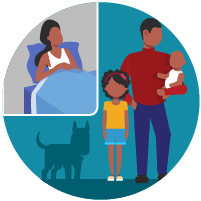
Minimize Contact
COVID-19 spreads between people who are in close contact (within about 6 feet) through respiratory droplets, created when someone talks, coughs or sneezes
- The caregiver, when possible, should not be someone who is at higher risk for severe illness from COVID-19.
- Use a separate bedroom and bathroom: If possible, have the person who is sick stay in their own “sick room” or area and away from others. If possible, have the person who is sick use a separate bathroom.
- Shared space: If you have to share space, make sure the room has good air flow.
- Open the window and turn on a fan (if possible) to increase air circulation.
- Improving ventilation helps remove respiratory droplets from the air.
Avoid having visitors: Avoid having any unnecessary visitors, especially visits by people who are at higher risk for severe illness.
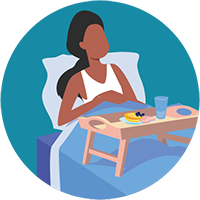
Eat in Different Rooms
- Stay separated: The person who is sick should eat (or be fed) in their room, if possible.
- Wash dishes and utensils using gloves and hot water: Handle any dishes, cups/glasses, or silverware used by the person who is sick with gloves. Wash them with soap and hot water or in a dishwasher.
Clean hands after taking off gloves or handling used items.
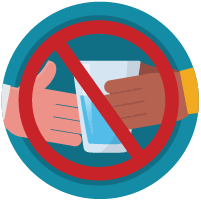
Do Not Share Personal Items
- Do not share: Do not share dishes, cups/glasses, silverware, towels, bedding, or electronics with the person who is sick.
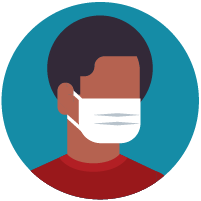
Wear Face-masks and Shields
- Sick person:
- The person who is sick should wear a cloth face covering when they are around other people at home and out (including before they enter a doctor’s office).
- The cloth face covering helps prevent a person who is sick from spreading the virus to others. It keeps respiratory droplets contained and from reaching other people.
- Cloth face coverings should not be placed on young children under age 2, anyone who has trouble breathing, or is not able to remove the covering without help.
- Caregiver:
- Wear gloves when you touch or have contact with blood, stool, or body fluids, such as saliva, mucus, vomit, and urine. Throw out gloves into a lined trash can.
- A caregiver may wear a cloth face covering when caring for a person who is sick, however the protective effects (how well the cloth face covering protects healthy people from breathing in the virus) are unknown.
- To prevent getting sick, make sure you practice everyday preventive actions: clean hands often, avoid touching your eyes, mouth, nose with unwashed hands, frequently clean and disinfect surfaces.
Note: During the COVID-19 pandemic, medical grade facemasks are reserved for healthcare workers and some first responders. You may need to improvise a cloth face covering using a scarf or bandana. Learn more here.
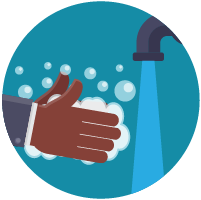
Wash Your Hands
- Wash hands: Wash your hands often with soap and water for at least 20 seconds. Tell everyone in the home to do the same, especially after being near the person who is sick.
- Hand sanitizer: If soap and water are not readily available, use a hand sanitizer that contains at least 60% alcohol. Cover all surfaces of your hands and rub them together until they feel dry.
- Hands off: Avoid touching your eyes, nose, and mouth with unwashed hands.
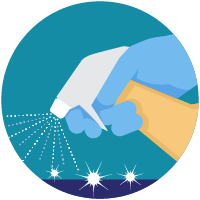
Clean Everything Thoroughly
Around the house
- Clean and disinfect “high-touch” surfaces and items every day: This includes tables, doorknobs, light switches, handles, desks, toilets, faucets, sinks, and electronics.
- Clean the area or item with soap and water if it is dirty. Then, use a household disinfectant.
- Be sure to follow the instructions on the label to ensure safe and effective use of the product. Many products recommend keeping the surface wet for several minutes to kill germs. Many also recommend wearing gloves, making sure you have good air flow, and wiping or rinsing off the product after use.
- Most household disinfectants should be effective. A list of EPA-registered disinfectants can be found hereexternal icon.
- To clean electronics, follow the manufacturer’s instructions for all cleaning and disinfection products. If those directions are not available, use alcohol-based wipes or spray containing at least 70% alcohol.
Bedroom and Bathroom
- If you are using a separate bedroom and bathroom: Only clean the area around the person who is sick when needed, such as when the area is soiled. This will help limit your contact with the sick person.
- If they feel up to it, the person who is sick can clean their own space. Give the person who is sick personal cleaning supplies such as tissues, paper towels, cleaners, and EPA-registered disinfectantsexternal icon.
- If sharing a bathroom: The person who is sick should clean and then disinfect after each use. If this is not possible, the caregiver and household member should wait as long as possible before entering the bathroom and clean and disinfect the bathroom before use.
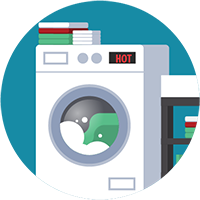
Your Laundry
- Do not shake dirty laundry.
- Wear disposable gloves while handling dirty laundry.
- Dirty laundry from a person who is sick can be washed with other people’s items.
- Wash items according to the label instructions. Use the warmest water setting you can.
- Remove gloves, and wash hands right away.
- Dry laundry, on hot if possible, completely.
- Wash hands after putting clothes in the dryer.
- Clean and disinfect clothes hampers. Wash hands after.
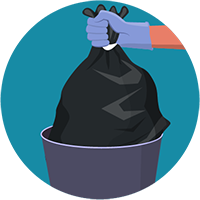
Line Your Trash Can
- Place used disposable gloves and other contaminated items in a lined trash can.
- Use gloves when removing garbage bags, and handling and disposing of trash. Wash hands afterwards.
- Place all used disposable gloves, facemasks, and other contaminated items in a lined trash can.
- If possible, dedicate a lined trash can for the person who is sick.
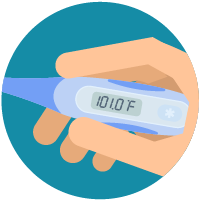
Monitor Your Health
- Caregivers and close contacts should monitor their health for COVID-19 symptoms.
- Common symptoms include fever, cough, and shortness of breath. Trouble breathing is a more serious warning sign that you need medical attention.
- Use CDC’s self-checker tool to help you make decisions about seeking appropriate medical care.
- If you are having trouble breathing, call 911.
- Call your doctor or emergency room and tell them your symptoms before going in. They will tell you what to do.
